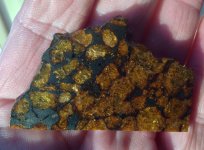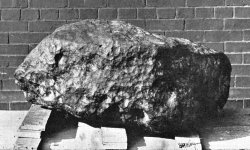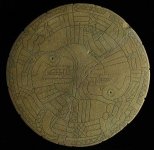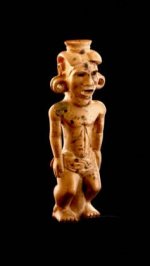Navigation
Install the app
How to install the app on iOS
Follow along with the video below to see how to install our site as a web app on your home screen.
Note: This feature may not be available in some browsers.
More options
You are using an out of date browser. It may not display this or other websites correctly.
You should upgrade or use an alternative browser.
You should upgrade or use an alternative browser.
Aztec Artifacts in the US ?
- Thread starter Samanthy
- Start date
MosesOfTheSouth
Full Member
nose ring was what i was told on the forum that is now gone.
there is a bit of purple/reddish little bits to it. it seems like it retained bits of whatever it was cast in, or the metal was not very refined. the area i found it in has an old legend of a lead mine that only the natives knew about. it is over all a mystery to me though. hard to research because i haven't really found any similar examples.
there is a bit of purple/reddish little bits to it. it seems like it retained bits of whatever it was cast in, or the metal was not very refined. the area i found it in has an old legend of a lead mine that only the natives knew about. it is over all a mystery to me though. hard to research because i haven't really found any similar examples.
BillA
Bronze Member
"an old legend of a lead mine that only the natives knew about"
more info ?
lead is easy relatively speaking, but what did they use it for ?
geologically speaking, is a lead mine (ore) occurrence likely in your area ?
more info ?
lead is easy relatively speaking, but what did they use it for ?
geologically speaking, is a lead mine (ore) occurrence likely in your area ?
Last edited:
BillA
Bronze Member
with Aztec artifacts in the US ?
no
no
BillA
Bronze Member
MOTS are you near a university where they may have a handheld XRF spectrometer unit ? (non-invasive)
your ring is interesting
your ring is interesting
Charl
Silver Member
This might be an interesting read. If you create an account with JSTOR, you can read it...
https://www.jstor.org/stable/43138520
Abstract
For over a century there has been a controversy over whether prehistoric Midwest Indians possessed the technology and skills needed to cast copper. The Great Lakes region is rich in native copper metal, and for thousands of years this supply supported a metal working industry (the Old Copper Complex), from which over twenty thousand copper artifacts have been found. Early archaeologists believed many of these artifacts were cast. Current thought states that the Indians did not have the technology to melt copper and thus did not cast. Newly discovered sites, artifacts, and experiments show evidence of a high heat technology most often associated with Hopewell and Mississippian cultures. This includes furnaces, tuyeres, crucibles, mold material, slag and castings, indicating the existence of an occisionally used metal-casting technology in prehistoric times.
https://www.jstor.org/stable/43138520
Abstract
For over a century there has been a controversy over whether prehistoric Midwest Indians possessed the technology and skills needed to cast copper. The Great Lakes region is rich in native copper metal, and for thousands of years this supply supported a metal working industry (the Old Copper Complex), from which over twenty thousand copper artifacts have been found. Early archaeologists believed many of these artifacts were cast. Current thought states that the Indians did not have the technology to melt copper and thus did not cast. Newly discovered sites, artifacts, and experiments show evidence of a high heat technology most often associated with Hopewell and Mississippian cultures. This includes furnaces, tuyeres, crucibles, mold material, slag and castings, indicating the existence of an occisionally used metal-casting technology in prehistoric times.
IMAUDIGGER
Silver Member
- Mar 16, 2016
- 3,398
- 5,195
- Primary Interest:
- All Treasure Hunting
Finds like that could change history if properly excavated and documented in an organized and professional manner.
It's not out of the question that someone could pick up a meteorite or natural nugget of metal and hammer something useful out of it..is it?
I've always found it odd that the local Native Americans didn't do this with the gold nuggets that had to have been laying on the surface of the bedrock along the rivers that they lived on. Seems very natural for a person to drill a hole in one for a bead or pendant. I wonder if it was taboo for some reason?
It's not out of the question that someone could pick up a meteorite or natural nugget of metal and hammer something useful out of it..is it?
I've always found it odd that the local Native Americans didn't do this with the gold nuggets that had to have been laying on the surface of the bedrock along the rivers that they lived on. Seems very natural for a person to drill a hole in one for a bead or pendant. I wonder if it was taboo for some reason?
welsbury
Bronze Member
I am surprised too that a Cali. native didn't pick up a nice flat nugget and put a hole in it. Bet they seen plenty.
Does your avatar have a few extra nuggets in pic?
Does your avatar have a few extra nuggets in pic?
BillA
Bronze Member
meteorite iron was refashioned by several civilizations, but working iron is more difficult than copper
not done in the Americas to my knowledge (I think there is an iron hammerstone ??)
except in the Pacific NW apparently they reworked iron bits from Japan ?
Charl, will try to get an acct
interesting, and this is an expression of indigenous technology ?
not done in the Americas to my knowledge (I think there is an iron hammerstone ??)
except in the Pacific NW apparently they reworked iron bits from Japan ?
Charl, will try to get an acct
interesting, and this is an expression of indigenous technology ?
IMAUDIGGER
Silver Member
- Mar 16, 2016
- 3,398
- 5,195
- Primary Interest:
- All Treasure Hunting
meteorite iron was refashioned by several civilizations, but working iron is more difficult than copper
not done in the Americas to my knowledge (I think there is an iron hammerstone ??)
except in the Pacific NW apparently they reworked iron bits from Japan ?
Charl, will try to get an acct
interesting, and this is an expression of indigenous technology ?
There are meteorites high in nickel.
IMAUDIGGER
Silver Member
- Mar 16, 2016
- 3,398
- 5,195
- Primary Interest:
- All Treasure Hunting
I am surprised too that a Cali. native didn't pick up a nice flat nugget and put a hole in it. Bet they seen plenty.
Does your avatar have a few extra nuggets in pic?
Sorry - no extras. Most of those were bartered away ;(
BillA
Bronze Member
all iron meteorites are high in nickel
stony meteorites are non-metallic
there are no soft/malleable meteorites
the iron from Japan floated here
stony meteorites are non-metallic
there are no soft/malleable meteorites
the iron from Japan floated here
BillA
Bronze Member
welsbury re gold ornaments
As I understand the evolution/progression, neolithic societies eventually developed to the point that some individuals had more status than others, and wanted to show the elevated status. The initial status pieces were colored rocks (medicine pouches) progressing to figures and jewellery in various colors (Olmec bluish jade, Maya bright green jade, Mescala dark green serpentine, etc.).
Then came gold, which notwithstanding its common occurrence in some areas, had been ignored. What changed ? Technology arrived, imported or indigenous ? Hammering, annealing, soldering, casting, alloying, tempering, surface etching, etc.
The neolithic society started changing into its next progression 'The Bronze Age' using copper and its alloys.
With the advent of gold ornamentation jade abruptly deceased being the main part of high-status burials.
I am not so familiar with the many smaller groups in the US area; I know some utilized and traded turquoise, were green rocks preferred (to exclusion ?) by any groups?
I know of no groups having gold status ornaments - they would have been killed after torturing for info. Just like to the south.
As I understand the evolution/progression, neolithic societies eventually developed to the point that some individuals had more status than others, and wanted to show the elevated status. The initial status pieces were colored rocks (medicine pouches) progressing to figures and jewellery in various colors (Olmec bluish jade, Maya bright green jade, Mescala dark green serpentine, etc.).
Then came gold, which notwithstanding its common occurrence in some areas, had been ignored. What changed ? Technology arrived, imported or indigenous ? Hammering, annealing, soldering, casting, alloying, tempering, surface etching, etc.
The neolithic society started changing into its next progression 'The Bronze Age' using copper and its alloys.
With the advent of gold ornamentation jade abruptly deceased being the main part of high-status burials.
I am not so familiar with the many smaller groups in the US area; I know some utilized and traded turquoise, were green rocks preferred (to exclusion ?) by any groups?
I know of no groups having gold status ornaments - they would have been killed after torturing for info. Just like to the south.
Back to the metal ornament. In Kentucky, there is an occurrence of millerite, at a place called "Hall's Gap. It is an ore of nickel, most likely of meteoric origin. That is my 2nd choice. First choice would be impure lead. Tennessee, and the surrounding areas have large deposits of lead.
MosesOfTheSouth
Full Member
i'm going to have to dig up the book or internet bookmark i have somewhere on that one. i've done a lot of research on the area i'm in, it's helped a lot. if the bricks start falling out of the walls in my house, should be able to patch them up with artifacts"an old legend of a lead mine that only the natives knew about"
more info ?
lead is easy relatively speaking, but what did they use it for ?
geologically speaking, is a lead mine (ore) occurrence likely in your area ?
 i will see if i can locate the passage and book it came from.
i will see if i can locate the passage and book it came from.no idea but that is a good idea. never thought of taking it to a local archaeologist.MOTS are you near a university where they may have a handheld XRF spectrometer unit ? (non-invasive)
your ring is interesting
great post. if it's from hall's gap it came down the Cumberland, then up the Caney, and other tributaries, or someone hoofed it about 150/160 miles. does unrefined lead not take on the white patina that more refined lead exhibits with age?Back to the metal ornament. In Kentucky, there is an occurrence of millerite, at a place called "Hall's Gap. It is an ore of nickel, most likely of meteoric origin. That is my 2nd choice. First choice would be impure lead. Tennessee, and the surrounding areas have large deposits of lead.
BillA
Bronze Member
MOTS a suggestion, at your leisure make a detailed writeup of the circumstances relating to your finding the ring, its subsequent cleaning, etc.
This is what each and every arche will ask and you might be ready the first time.
I too am curious about the lead oxide (crust ?).
edit: it seems lead does not naturally occur in a malleable form, which implies . . .
This is what each and every arche will ask and you might be ready the first time.
I too am curious about the lead oxide (crust ?).
edit: it seems lead does not naturally occur in a malleable form, which implies . . .
Last edited:
southfork
Bronze Member
https://www.enotes.com/homework-help/which-ore-malleable-lead-tin-483285
Lead Ore needs to be smelted .
Characteristic malleability would be a substance which can be hammered into a thin sheet, like copper. Lead deposits occur commonly in nature, primarily found in the form of galena ore. Galena is quite brittle, but after smelting, the liberated lead is malleable. Other forms of lead ore like anglesite, boulangerite, and cerussite are also brittle.
Lead Ore needs to be smelted .
Characteristic malleability would be a substance which can be hammered into a thin sheet, like copper. Lead deposits occur commonly in nature, primarily found in the form of galena ore. Galena is quite brittle, but after smelting, the liberated lead is malleable. Other forms of lead ore like anglesite, boulangerite, and cerussite are also brittle.
Charl
Silver Member
I've collected meteorites since the early 80's. At times I've combined the hobbies. For instance, I have a slice of the Bonita Springs, Florida stone meteorite, which was found in an Indian mound:
BONITA SPRINGS PHOTO
There are three main types of meteorites, iron(which are actually nickle-iron), stony iron, which are a mix of silicate(stone) and nickle-iron, and stony meteorites. Almost all stony meteorites will contain a certain percentage of nickle-iron embedded in the silicate matrix.
One group of natives, the Inuit of Greenland(technically, Greenland is part of North America) were able to use meteoritic iron. The Inuit had access to several huge masses of a single iron meteorite fall known as the Cape York meteorite. Explorer Robert Peary removed three of the Cape York irons and transported them to New York City, for the American Museum of Natural History:
https://www.ironfromthesky.org/?p=310
We are all familiar with Meteor Crater, Az., an impact Crater created by the impact of a huge iron meteorite some 50,000 years ago. It's known as the Canyon Diablo meteorite. There are two sites, associated with different groups of Ancestral Puebloan people, where shrines were located containing portions of the Canyon Diablo meteorite:
Prehistoric Meteorite ?Shrines? in Arizona May Be Linked, Says Archaeo-Astronomer ? Western Digs
Then there was the Hopewell culture. They too collected meteorites. In particular they collected samples of the Brenham, Kansas stony-iron meteorite. There are two types of stony irons. Brenham is a type known as a pallasite, which is comprised of a nickle-iron matrix in which are embedded olivine crystals. When such crystals are gem quality, they are known as peridot crystals. I don't have a specimen, but if you watched the recent series called "Meteorite Men", you may recall that collector/hunter Steve Arnold located the largest mass of the Brenham meteorite ever found. Here is a slice I have of the Imilac, Chile(Atacama Desert) pallasite, so you can see what a pallasite looks like. They are the most attractive, to most collectors anyway, of the three main types of meteorites. As well, here is a description of the various ways the Hopewell utilized meteorites:
https://www.ohiohistory.org/learn/c...013/june-2013/hopewell-use-of-meteoritic-iron

Finally, there is the Willamette iron meteorite from Oregon, the largest meteorite ever found in the United States. It was sacred to several tribes. It is displayed at the AMNH in New York, and in recent years, the museum and tribes reached an agreement where the tribes are allowed to visit the meteorite for ceremonial purposes:
https://www.amnh.org/exhibitions/permanent/the-universe/willamette-meteorite-agreement
Almost forgot this one, and it's quite impressive. Found enshrined at the great pueblo known as Casas Grandes, in northern Mexico, and known as the Casas Grandes meteorite:
https://www.meteorite-times.com/a-grand-meteorite-from-a-grand-house/
It was found wrapped like a mummy, and weighing 5400 pounds!

BONITA SPRINGS PHOTO
There are three main types of meteorites, iron(which are actually nickle-iron), stony iron, which are a mix of silicate(stone) and nickle-iron, and stony meteorites. Almost all stony meteorites will contain a certain percentage of nickle-iron embedded in the silicate matrix.
One group of natives, the Inuit of Greenland(technically, Greenland is part of North America) were able to use meteoritic iron. The Inuit had access to several huge masses of a single iron meteorite fall known as the Cape York meteorite. Explorer Robert Peary removed three of the Cape York irons and transported them to New York City, for the American Museum of Natural History:
https://www.ironfromthesky.org/?p=310
We are all familiar with Meteor Crater, Az., an impact Crater created by the impact of a huge iron meteorite some 50,000 years ago. It's known as the Canyon Diablo meteorite. There are two sites, associated with different groups of Ancestral Puebloan people, where shrines were located containing portions of the Canyon Diablo meteorite:
Prehistoric Meteorite ?Shrines? in Arizona May Be Linked, Says Archaeo-Astronomer ? Western Digs
Then there was the Hopewell culture. They too collected meteorites. In particular they collected samples of the Brenham, Kansas stony-iron meteorite. There are two types of stony irons. Brenham is a type known as a pallasite, which is comprised of a nickle-iron matrix in which are embedded olivine crystals. When such crystals are gem quality, they are known as peridot crystals. I don't have a specimen, but if you watched the recent series called "Meteorite Men", you may recall that collector/hunter Steve Arnold located the largest mass of the Brenham meteorite ever found. Here is a slice I have of the Imilac, Chile(Atacama Desert) pallasite, so you can see what a pallasite looks like. They are the most attractive, to most collectors anyway, of the three main types of meteorites. As well, here is a description of the various ways the Hopewell utilized meteorites:
https://www.ohiohistory.org/learn/c...013/june-2013/hopewell-use-of-meteoritic-iron

Finally, there is the Willamette iron meteorite from Oregon, the largest meteorite ever found in the United States. It was sacred to several tribes. It is displayed at the AMNH in New York, and in recent years, the museum and tribes reached an agreement where the tribes are allowed to visit the meteorite for ceremonial purposes:
https://www.amnh.org/exhibitions/permanent/the-universe/willamette-meteorite-agreement
Almost forgot this one, and it's quite impressive. Found enshrined at the great pueblo known as Casas Grandes, in northern Mexico, and known as the Casas Grandes meteorite:
https://www.meteorite-times.com/a-grand-meteorite-from-a-grand-house/
It was found wrapped like a mummy, and weighing 5400 pounds!

Last edited:
monsterrack
Silver Member
- Apr 15, 2013
- 4,419
- 5,819
- Detector(s) used
- Garrett, and Whites
- Primary Interest:
- All Treasure Hunting
newnan man
Gold Member
BillA
Bronze Member
ear spools ?
did the Adena use ear spools ?
did the Adena use ear spools ?
Top Member Reactions
-
 3358
3358 -
 1989
1989 -
 1932
1932 -
 1164
1164 -
 1096
1096 -
 890
890 -
 806
806 -
 797
797 -
 794
794 -
 788
788 -
 751
751 -
 537
537 -
 484
484 -
 460
460 -
 444
444 -
 425
425 -
 422
422 -
 420
420 -
E
409
-
 383
383
Users who are viewing this thread
Total: 3 (members: 0, guests: 3)








